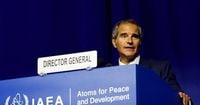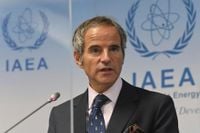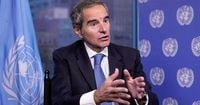On October 29, 2025, the world’s attention again turned to Iran’s nuclear program as Rafael Mariano Grossi, Director General of the International Atomic Energy Agency (IAEA), addressed mounting international speculation. In a series of interviews with major outlets, including the Associated Press and Reuters, Grossi stated plainly that Iran is not actively enriching uranium, despite renewed movement detected at several of its nuclear sites. His remarks, coming on the heels of a turbulent summer marked by military strikes and diplomatic breakdowns, have done little to settle the nerves of global observers.
“We do not see anything that would give rise to hypothesis of any substantive work going on there,” Grossi told reporters in New York, as quoted by Reuters. He clarified that while the IAEA is conducting inspections in Iran, those visits have not included the three key nuclear facilities bombed by the United States in June—Fordow, Natanz, and Isfahan. Instead, the agency is “gradually coming back” to its regular inspection regime, though not yet at full capacity. “We are not inspecting the stricken sites ... we are in discussion with Iran,” Grossi added.
The context for this heightened scrutiny is a dramatic escalation earlier in the year. On June 13, 2025, Israel launched a surprise attack on Iranian nuclear and military facilities, citing fears that Iran was edging dangerously close to developing nuclear weapons. The United States soon joined in, dropping bunker-busting bombs on Fordow, Natanz, and Isfahan—three of Iran’s most significant nuclear plants. According to UNN and other sources, the strikes caused serious, though not total, damage to the sites. This assessment directly contradicted the more sweeping claims made by former U.S. President Donald Trump, who asserted that Iran’s nuclear facilities were “completely destroyed.”
Despite the devastation, the uranium itself appears to have survived mostly intact. Grossi told Swiss newspaper Neue Zürcher Zeitung that most of Iran’s 60% enriched uranium stock remains at the nuclear facilities in Isfahan and Fordow, with some stored at Natanz. “The facilities were massively damaged, but the uranium itself was largely unaffected,” Grossi confirmed. A leaked IAEA report from September 2025 indicated that Iran’s stockpile stood at 440 kilograms as of June; Grossi now estimates it at approximately 400 kilograms. This amount, according to experts cited by the Center for Strategic and International Studies (CSIS), could theoretically allow Iran to build up to 10 nuclear bombs—though Iran continues to insist that its program is entirely peaceful.
What has truly unsettled the international community, however, is not what has been found, but what remains hidden. Since the June bombings, the IAEA has relied heavily on satellite imagery to monitor Iran’s activities. Inspectors have observed significant movement around nuclear stockpile sites, particularly at a facility known as Pickaxe Mountain. Satellite photos analyzed by the CSIS reveal new security walls and the construction of tunnels at several locations. The think tank has outlined three possible explanations for the construction: Iran could be building a centrifuge assembly facility as originally planned, expanding Pickaxe Mountain to include metallurgy (after the previous metallurgy site at Isfahan was destroyed), or, most concerning to the West, developing a new uranium enrichment facility. There is also the possibility that Iran is using Pickaxe Mountain as a cover to covertly move its nuclear program to other, more secure locations.
Iranian President Masoud Pezeshkian, responding to the international uproar, dismissed the satellite imagery as inconclusive and called for IAEA inspectors to be allowed on the ground to verify the site’s true purpose. However, Iran’s cooperation with the IAEA has been far from straightforward. Following the Israeli and U.S. strikes, Iran severed ties with the agency, later reestablishing a limited framework that permits UN inspectors into nuclear sites only with the explicit approval of Iranian security services. Earlier this month, Iranian Foreign Minister Abbas Araghchi declared that even this agreement was now void, citing the activation of the so-called “snapback” mechanism by European powers, which reinstates sanctions and tightens oversight.
The result is a tense standoff. The IAEA continues to push for more access, particularly to verify that the 60% enriched uranium has not been diverted for military use. “Will we get access to this uranium? And what will happen to it then? Will Iran want to keep it, will it reduce its enrichment levels again, or will Iran move this uranium abroad?” Grossi wondered aloud in his interview with Neue Zürcher Zeitung. He stressed the importance of dialogue: “Sitting down together at the table saves us the danger of another round of bombing and attacks.”
For now, Grossi’s team has not seen any evidence—via satellite or on the ground—of Iran accelerating uranium production. “Enrichment levels were the same before the 12-day war with Israel began in June,” he told the Associated Press. Still, the fact that the nuclear material enriched at 60% remains in Iran is a point of ongoing discussion and concern. “We need to go back there and to confirm that the material is there and it’s not being diverted to any other use,” Grossi said.
Yet, the IAEA’s ability to provide real answers is hampered by its limited access. Movement at major industrial sites, as seen through satellite imagery, can only tell so much. “These are big industrial sites where there is movement, there is activity going on and we are very quick to indicate that this does not imply that there is activity on enrichment,” Grossi explained to Reuters. He made it clear that inspectors have not observed any “substantive work” related to uranium enrichment at the sites they have been able to visit.
Meanwhile, the international community remains on edge. Israel and the United States have both made it clear that they will not tolerate a nuclear-armed Iran, and European powers are increasingly wary of Tehran’s intentions. The ambiguity surrounding Iran’s current activities—compounded by the lack of direct oversight—fuels speculation and mistrust on all sides. Iran, for its part, continues to maintain that its nuclear ambitions are peaceful, a claim met with skepticism by many in the West given the country’s history and the clandestine nature of its program prior to 2003, as previously documented by the IAEA.
As the world waits for clarity, the stakes remain high. The delicate dance between transparency and suspicion, diplomacy and brinkmanship, continues to shape the fate of Iran’s nuclear program—and, by extension, the security landscape of the entire Middle East.
For now, the only certainty is uncertainty itself. With Iran’s uranium stockpile untouched but its intentions unclear, the path forward will depend as much on political will as on technical verification. The world watches, hopeful for dialogue but braced for escalation.


